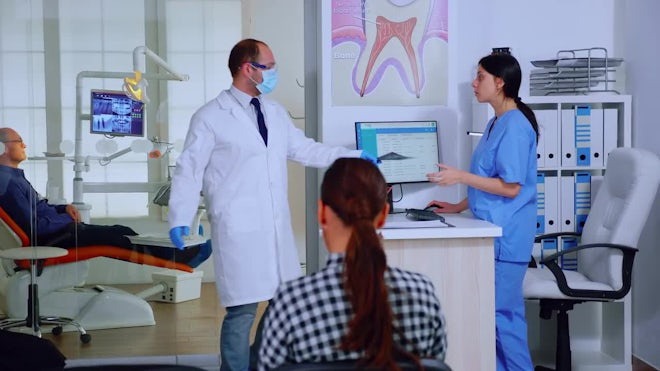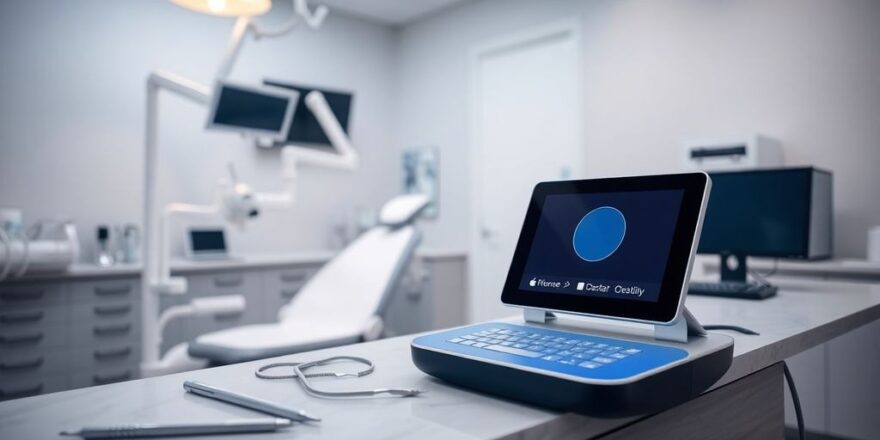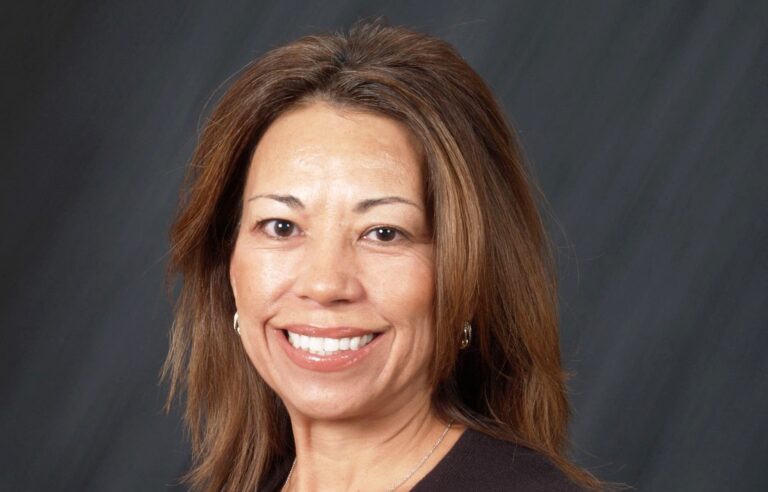Running a dental practice today means managing more than just patient care. Administrative work, insurance claims, scheduling, charting, billing, and compliance often consume as much time as clinical duties.
The most effective way to reduce this burden is to systematically separate what truly requires human judgment from what can be automated or delegated.
By optimizing workflows, standardizing documentation, and leveraging modern dental software, offices can free up 20–40% of staff time without sacrificing quality or compliance.
1. Standardize and Streamline Workflows

Administrative overload often begins with inconsistent systems.
When each assistant, hygienist, or front-desk staff member handles tasks differently, the result is duplicated effort and errors.
To solve this, create clear, step-by-step protocols for common administrative processes such as:
- Insurance verification and claim submission
- Appointment confirmations and cancellations
- Charting and patient intake updates
- End-of-day reporting and reconciliation
Documenting these in shared digital SOPs (standard operating procedures) ensures everyone works the same way.
Standardization also makes it easier to train new staff and reduces confusion when tasks are delegated.
| Task | Problem | Streamlined Solution |
| Insurance verification | Different staff use different portals | Create one verified workflow and checklist for all carriers |
| Appointment scheduling | Overlaps or gaps | Use centralized scheduling software with real-time updates |
| End-of-day reports | Paper logs and manual tallies | Automate reporting within the PMS (Practice Management System) |
2. Automate Repetitive Tasks with Smart Tools
Modern dental offices generate a vast amount of data daily, most of it routine. Repetitive administrative actions like data entry, reminders, billing, and compliance documentation can now be automated through intelligent systems.
Automation doesn’t replace staff; it eliminates unnecessary manual work. Automated systems can:
- Send appointment reminders via SMS or email
- Generate follow-up messages for recalls or treatments
- Auto-populate insurance forms and billing details
- Flag incomplete patient records or missing signatures
- Create reports for production, collection, and aging accounts.
Using platforms built around Trust AI helps practices centralize these processes under a single interface.
Such AI-driven tools don’t just speed up admin work; they learn patterns and optimize task routing, ensuring staff spend more time with patients and less time with paperwork.
By integrating automation into existing workflows, practices can reduce administrative workload by up to 35% while maintaining compliance accuracy.
3. Delegate and Cross-Train the Team

In many small to mid-sized dental practices, administrative stress builds because key duties fall on just one or two people. When a front-desk coordinator handles insurance, billing, and scheduling, burnout and errors become inevitable.
The solution is structured delegation and cross-training. Create defined “zones of responsibility” and backup roles for all non-clinical work. For example:
- Front desk: scheduling, patient intake, appointment reminders
- Billing coordinator: insurance claims, collections, aging reports
- Assistant or hygienist support: digital charting and procedure notes
Cross-training ensures continuity during absences and distributes the workload evenly. It also gives team members a perspective on how their tasks affect others, improving collaboration.
When combined with automation tools, this approach turns administrative work into an organized system rather than a daily scramble.
4. Optimize Communication Channels
Administrative time is often lost to poor communication. Endless email chains, verbal instructions, and sticky notes lead to confusion and rework. Clear communication systems, both digital and internal, are key to efficiency.
Effective strategies include:
- Using centralized messaging tools integrated with the dental PMS (e.g., internal chat for staff coordination).
- Implementing task-tracking dashboards that show who is responsible for which administrative task.
- Scheduling weekly 10-minute syncs to review bottlenecks, unpaid claims, or recurring issues.
In larger offices, implementing a shared inbox or ticketing system helps ensure patient requests and insurance queries are never lost or duplicated.
5. Go Paperless, but Do It Strategically
While many practices talk about “going paperless,” few execute it well. Scanning everything without structure can create digital clutter as bad as paper.
The key is to build digital systems around retrieval, not just storage.
Start by digitizing high-volume workflows such as:
- Patient intake forms and consent documents
- Treatment plans and signatures
- Insurance claim forms and EOBs
- Lab orders and correspondence
A well-organized document management system allows for quick searching and reduces hours wasted on filing and retrieving paperwork.
| Before Digitalization | After Digitalization |
| Staff manually scan and name each document | Forms are automatically uploaded and categorized by patient ID |
| Paper charts take up physical space | Encrypted storage in secure cloud folders |
| Hard to share information | Instant access from any authorized workstation |
6. Use Data Analytics to Guide Priorities

Administrative inefficiency often hides in plain sight. Without tracking how staff spend time, you can’t see what drains productivity. Most modern practice management systems and AI dashboards now provide detailed metrics on scheduling patterns, claim turnaround times, and staff task loads.
For example:
- Claim Rejections: Identify frequent rejection reasons and fix them at the source (incorrect codes, missing data).
- Scheduling Gaps: Detect peak cancellation hours and use automated waitlist filling.
- Billing Delays: Flag accounts with aging over 60 days for automated follow-up.
By reviewing this data monthly, dental offices can make informed decisions that continuously reduce administrative friction.
7. Simplify Insurance and Billing Processes
Insurance administration is one of the top causes of burnout in dental offices. Between pre-authorizations, coding accuracy, and EOB posting, it can consume hours daily.
To reduce the load:
- Batch process claims rather than handling them individually.
- Use eligibility verification tools that check multiple carriers simultaneously.
- Integrate auto-posting for insurance payments.
- Set automated reminders for pending pre-authorizations.
Automated claim management and real-time eligibility tools can reduce claim turnaround times by over 50%. That means fewer phone calls to carriers and faster payments, two of the biggest wins for any dental office.
8. Invest in Integrated Systems Instead of Multiple Platforms

Fragmentation is another hidden administrative burden. Many offices use separate tools for scheduling, billing, imaging, and communication. Switching between them adds unnecessary clicks, logins, and data mismatches.
The smarter approach is to consolidate into a unified system that links scheduling, billing, clinical notes, and insurance tracking under one roof. The fewer systems staff need to learn and update, the lower the administrative overhead.
Integrated solutions not only simplify staff routines but also improve patient experience, reducing wait times, billing errors, and missed follow-ups.
9. Schedule Regular Process Audits
Even the most efficient system needs maintenance. Quarterly process audits help catch inefficiencies before they pile up.
During these reviews, look for:
- Redundant manual steps that could be automated
- Bottlenecks in scheduling or claims processing
- Communication gaps between clinical and admin staff
- Outdated SOPs that no longer match current tools
Encouraging staff feedback during these audits creates buy-in and often reveals practical improvements leadership might overlook.
10. Protect Staff Well-Being Through Smarter Work Design

Reducing administrative burden isn’t just about productivity; it’s about sustainability. Overworked office teams are more likely to make mistakes, suffer burnout, and leave, which only increases administrative chaos.
Flexible scheduling, clear boundaries between clinical and administrative time, and consistent feedback loops help prevent that spiral.
Investing in automation or AI tools isn’t about replacing staff; it’s about protecting them from repetitive, demoralizing work that distracts from patient care.
Final Thoughts
Reducing administrative burden in dental offices isn’t achieved through a single fix; it’s the result of continuous improvement, smarter tools, and better-defined systems.
The combination of workflow standardization, targeted automation, and well-distributed responsibility creates a lean, resilient administrative structure.
Related Posts:
- Understanding the Importance of Dental Insurance for…
- Navigating the Complexities of Medical Billing Codes…
- 20 Best Gaming Headset Under 50$ 2024 - for PC, PS4,…
- 15 Best Shoes for Jumping Rope 2024 - Maintain a…
- From Private Practice to DSOs: What LA Dentists Need…
- 15 Best Shoes for Walking on Concrete 2024 - Soft &…







